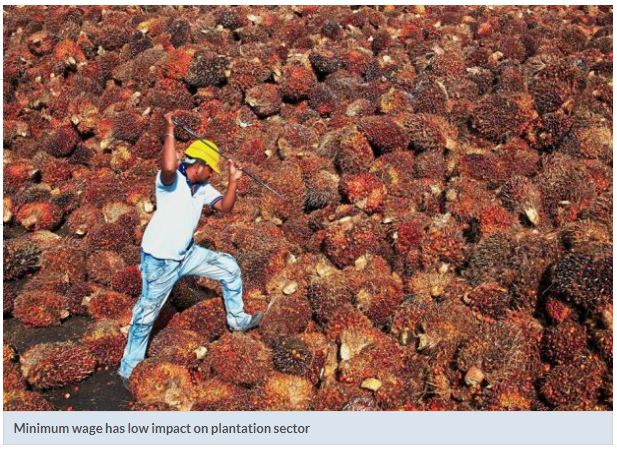Malaysia: Industries breath sigh of relief on minimum wage increase impact
PETALING JAYA: The announcement on the new minimum wage caught almost everyone by surprise.
The market had been bracing for a much higher increase, expecting a hike of RM150 per month, with some labour-intensive sectors preparing for a big hit.
There was much concern over the issue as Pakatan Harapan, in its election manifesto had pledged to increase minimum wage to RM1,500.
However, on Wednesday, the Prime Minister’s Department said the minimum wage for workers in Peninsular Malaysia would be raised by RM50 to RM1,050.
Wages of workers in Sabah and Sarawak is to be increased from RM920 to bring it to the same level as those working in Peninsular Malaysia.
While the increase in Sabah and Sarawak is somewhat significant, for workers in Peninsular Malaysia, which represents a large majority of the working force, the quantum of raise is almost negligible.
How much of a difference does RM50 a month make today? Workers looking for a significant increase were left bitterly disappointed with many politicians from both sides of the divide, consumer and workers groups criticising the move.
Businesses, on the other hand, breathed a huge sigh of relief.
Even the plantation sector, which is heavily reliant on workers, will not see much impact from the minimum wage increase, apart from those with higher exposure in Sabah and Sarawak.
This is because the percentage change of new minimum wage is lower than the two previous revisions.
According to MIDF Research, the minimum wage growth in 2016 as compared to 2013 for Peninsular Malaysia and Sabah & Sarawak was 11.1% and 15%, respectively.
Comparatively, the 2019 minimum wage shall see a 5% and 14.1% uplift for Peninsular Malaysia and Sabah & Sarawak.
Hence, the research house said that the new minimum wage level would have a trivial impact toward business activities in Malaysia, via changes in cost structure.
Going forward, accommodative tax policies and stable fuel prices will provide extra room for businesses to invest and expand their business activities from low to high-value stages.
The new government has also promised to prioritise local workers and reduce the number of foreign workers.
In line with this, MIDF Research expected a solid increase in employment of medium and high-skilled workers as well as bright prospects for continuous solid wage growth in 2018 and in the long term.
Besides that, given that economic indicators of domestic and global economic activities are showing signs of sustained recovery, the wage growth for manufacturing and services sectors are expected to perform better than 2017
Moreover, as exports and industrial productions continue expanding, they are expected to translate into better performance in employment and wage growth especially in manufacturing sector.
Added with supportive economic policies and low inflationary pressure, it said solid wage growth will positively contribute to domestic consumption in 2018.
Wage growth in manufacturing sector expanded by 1.8% in 2017. As for services sector, wage growth went up by 3.4%.
Firmer wage growth in certain sub-sectors such as utilities, wholesale & retail trade activities and transportation & storage activities contributed towards the steady wage growth in overall services sector.
“We expect inflation to average at 1.3% this year, mainly driven by unfavourable base effects, zero-rated GST and stabilised retail fuel prices.
“As inflationary pressure remains steady, we anticipate this will translate into an improved labour market with unemployment rate projected at 3.3%,” said MIDF Research.
While the minimum wage hike is seen as negative news, most sectors shall see only a minimal impact on earnings.
PublicInvest Research opined that there will not be a significant impact of the minimum wage on planters’ cost.
In fact, fresh fruit bunches harvesters’ monthly salary already exceeded RM1,050, and they make up more than 85% of labour for plantation companies.
Net increase in cost is estimated to be between 1% and 1.5% for financial year 2019.
The same applies for the consumer sector, where large food and beverage manufacturers such as Nestlé (Malaysia) Bhd and F&N Holdings Bhd, have already paid above the new minimum wage of RM1,050 for most of their staff.
In addition, most of the manufacturing sites are in Peninsular Malaysia, where the increment from the previous minimum wage is only 5%.
MIDF Research believed that Nestle Malaysia and F&N will be able to absorb the recent hike in minimum wage due to the recent cost savings generated from reduction in number of staff as a result of increasing automation at their plants, leaner operation structure, as well as recent decline in raw material prices such as sugar, palm oil and coffee beans.
Furthermore, most employees in the glove manufacturing sector are already earning more than RM1,050.
Employees that fall below the minimum wage requirements are estimated to be less than 10% of the total employees.
Hence, the impact on earnings to glove manufacturers will be less than 1%.
As for small and medium enterprises, the 5% increase should be manageable for business owners in Peninsular Malaysia.
The impact on cost of goods sold (COGS) for manufacturers with main operations in Peninsular Malaysia are expected to be minimal, ranging from 0.75% to 1.5%, while Sabah and Sarawak manufacturers’ COGS are expected at between 2.1% and 4.2%.
“As the implementation of the minimum wage is more than one quarter away, businesses will have time to plan and budget so that the rise in operating cost is smoothened out,” said MIDF Research.
Source: https://www.thestar.com.my/business/business-news/2018/09/11/industries-breathe-sigh-of-relief/#sokHQ4Gfv1qoBZTW.99


 English
English




